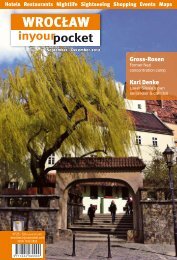VILNIUS - In Your Pocket
VILNIUS - In Your Pocket
VILNIUS - In Your Pocket
You also want an ePaper? Increase the reach of your titles
YUMPU automatically turns print PDFs into web optimized ePapers that Google loves.
Presidential Palace (Prezidentūra) C-2, S. Daukanto<br />
Aikštė 3/8, www.president.lt. The official residence<br />
of the President of Lithuania, the Presidential Palace started<br />
life in the 14th century as a much smaller structure built<br />
at the behest of the city’s first Bishop, Andrzej Jastrzębiec<br />
(?-1398). Gaining its late Classical appearance much later,<br />
the building remained the home of the cream of the city’s<br />
Catholic clergy until the 1795 Partition when it became<br />
the residential address of Vilnius’ tsarist governors. Many<br />
illustrious figures have spent a night in the building over the<br />
centuries, among them Tsar Alexander I, Napoleon Bonaparte<br />
and local boy, some-time dictator, military giant and<br />
Polish national hero Józef Piłsudski (1867-1935) to name<br />
but a few. After independence in 1990 the building served<br />
several purposes until assuming its current role in 1997.<br />
The presidential flag can be seen flying over the building<br />
when the President is in residence or in the city. Changing<br />
of the Guard takes place on Sundays at 12:00. Q Free<br />
tours of the Presidential Palace take place on Fridays and<br />
Saturdays. Tours are limited to 25 people and are currently<br />
in Lithuanian only. For more information, see www.president.<br />
lt or call tel. (+370) 5 266 40 73. J<br />
Stebuklas C-2, Arkikatedros Square. About halfway<br />
between the Cathedral and the bell tower is the stebuklas,<br />
or miracle. Essentially a piece of stone believed to perform<br />
wonders and with the word stebuklas written on it, the site<br />
marks the spot where one end of the human chain of some<br />
two million protesting Lithuanians, Latvians and Estonians<br />
stretching the 650km or so to Tallinn was formed on August<br />
23, 1989. A symbol of freedom and hope, stand on the miracle,<br />
turn a complete clockwise circle and make a wish. J<br />
vilnius.inyourpocket.com<br />
vilnius.inyourpocket.com<br />
what to see<br />
Television Tower (Televizijos Bokštas) Sausio 13osios<br />
10, tel. (+370) 5 252 53 33, www.lrtc.net. The<br />
tallest building in Lithuania, the 326m Television Tower was<br />
built from reinforced concrete and steel between 1974 and<br />
1980 to a design by V. Obydovas and K. Balėnas. On January<br />
13, 1991 as the disintegration of the USSR reached a frenzied<br />
pace and Moscow attempted to retake control of the Lithuanian<br />
media, Soviet tanks surrounded it in an assault that<br />
killed 13 unarmed civilians. The tower has since become a<br />
potent Lithuanian symbol. Around it are a few monuments and<br />
photographs of those who lost their lives and whose names<br />
the nearby streets are now called in honour of. <strong>In</strong>side at<br />
ground level is the small Sausio 13-osios Ekspozicija (January<br />
13th Exhibition) commemorating the brutal events including<br />
a copy of the original Soviet military attack plan, weapons<br />
used to beat protesters and some disturbing photographs.<br />
The exhibition is free, although the 40-second ride in the lift<br />
to visit the combined 270m restaurant and viewing station<br />
isn’t. The ticket office also sells several Television Tower<br />
souvenirs. A taxi from Old Town costs somewhere in the<br />
region of 20Lt. Alternatively, take trolleybus Nº1, 3, 7 or 16<br />
to the Televizijos Bokštas stop. Q Open 10:00 - 22:00. Last<br />
entrance 21:00. Admission 21Lt.<br />
Town Hall (Rotušė) C-4, Didžioji 31, tel. (+370) 5 261<br />
80 07, www.vilniausrotuse.lt. First mentioned in 1503,<br />
the Town Hall most likely dates from the 15th century, while<br />
the present Classical structure was built at the end of the<br />
18th century. <strong>In</strong> 1810 the governor general ordered that the<br />
Town Hall housed a theatre, which gave performances on and<br />
off until 1924. Since then its interior has been a museum.<br />
Until the reestablishment of independence it served as the<br />
Lithuanian Art Museum. Today it’s the Artists’ Palace where<br />
you can see gallery art. QOpen 09:00 - 18:00. Closed Sat,<br />
Sun. J<br />
August - November 2012<br />
63
















